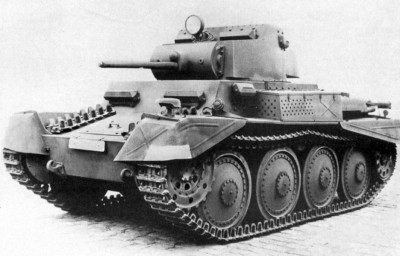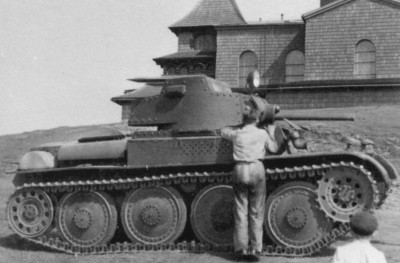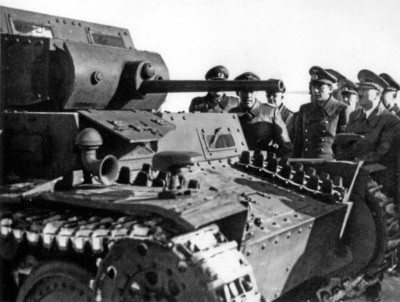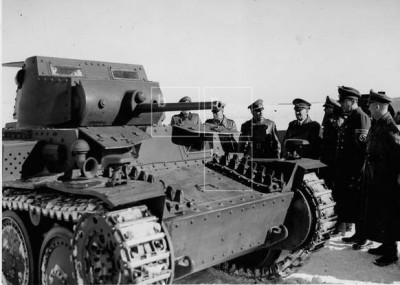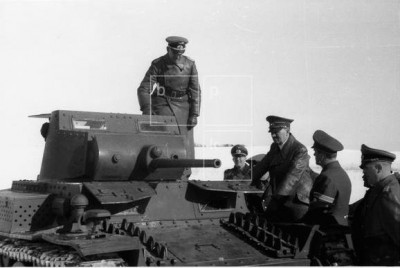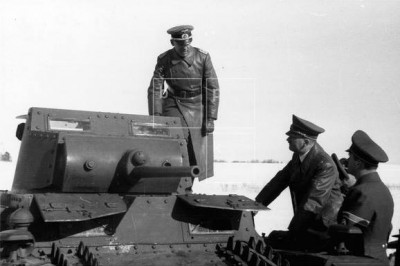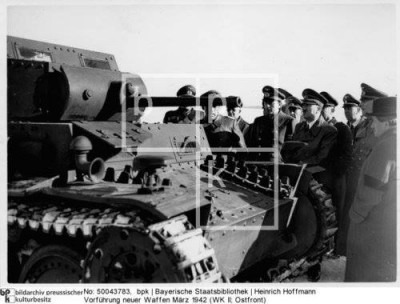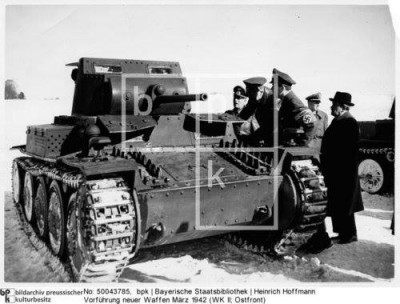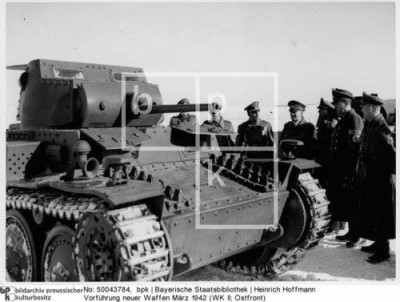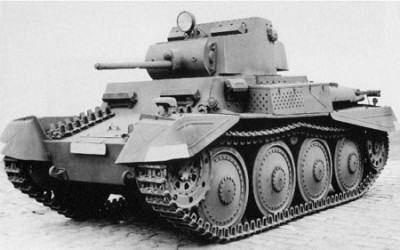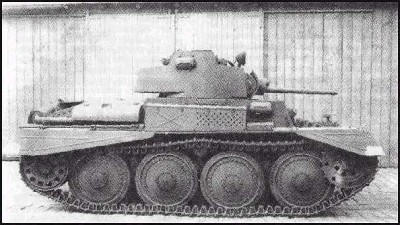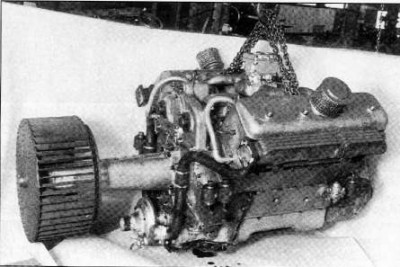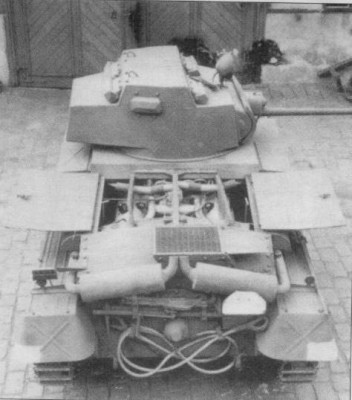| Název: Name: | Pz.Kpfw. 38(t) neuer Art | Pz.Kpfw. 38(t) neuer Art |
| Originální název: Original Name: | Pz.Kpfw. 38(t) neuer Art | |
| Kategorie: Category: | lehký tank | light tank |
| Výrobce: Producer: | DD.12.1941-DD.04.1942 Böhmisch-Mährische Maschinenfabrik AG, Praha | |
| Období výroby: Production Period: | DD.12.1941-DD.04.1942 | |
| Vyrobeno kusů: Number of Produced: | 5 | |
| Prototyp vyroben: Prototype Built: | DD.12.1941 | |
| Osádka: Crew: | 4 | |
| Technické údaje: Technical Data: | ||
| Bojová hmotnost: Combat Weight: | 11800 kg | 26015 lb |
| Délka s kanónem dopředu: Length with Gun Forward: | 4620 mm | 15 ft 1 ⅞ in |
| Délka korby: Hull Length: | 4620 mm | 15 ft 1 ⅞ in |
| Celková šířka: Overall Width: | 2260 mm | 7 ft 5 in |
| Celková výška: Overall Height: | 2170 mm | 7 ft 1 ⅜ in |
| Světlá výška: Ground Clearance: | 360 mm | 1 ft 2 ⅛ in |
| Šířka pásu: Track Width: | 305 mm | 1 ft |
| Měrný tlak: Ground Pressure: | 0,06 MPa | 8.7 psi |
| Pancéřování: Armour: | 8-30 mm (štít kanóna - 50 mm) | 8-30 mm (gun shield - 50 mm) |
| Pohon: Propulsion: | ||
| Typ: Type: | Praga NR (NRI) (vodou chladený zážihový 8-valec objemu 14236 cm3 (195 kW) 3. prototyp - Tatra T-103 (vznetový vzduchom chladený 12-valec objemu 14.825 cm3) | Praga NR (NRI) (8 cyl., water cooled, gasoline, 14236 ccm (195 kW) 3rd prototype - Tatra T-103 (12 cyl., diesel, air cooled, 14.825 ccm) |
| Výkon: Power: | 183,3 kW při 2500 ot/min | 245.8 bhp at 2500 rpm |
| Převodové ústrojí: Transmission: | Praga Wilson (5+R) | Praga Wilson (5+R) |
| Výkony: Performance: | ||
| Rychlost na silnici: Road Speed: | 64 km/h | 40 mph |
| Rychlost v terénu: Cross-country Speed: | ? km/h | ? mph |
| Jízdní dosah po silnici: Cruising Range on Road: | 200 km | 124 mi |
| Jízdní dosah v terénu: Cross-country Cruising Range: | ? km | ? mi |
| Překonávání překážek: Obstacles Crossing: | ||
| Svah: Gradient: | ? ° | ? % |
| Boční náklon: Side Slope: | ? ° | ? % |
| Překročivost: Trench Crossing: | 2,1 m | 83 in |
| Výstupnost: Vertical Obstacle: | 0,8 m | 31 in |
| Brodivost: Fording Depth: | 1 m | 39 in |
| Výzbroj: Armament: | ||
| Hlavní: Main: | 3,7 cm Škoda A19 (90 nábojov) | 3,7 cm Škoda A19 (90 rounds) |
| Vedlejší: Secondary: | guľomet MG 34 ráže 7,92 mm (700 nábojov) | machine gun MG 34 cal. 7,92 mm (700 rounds) |
| Uživatelské státy: User States: | - | - |
| Poznámka: Note: | - | - |
| Zdroje: Sources: | Vladimír Francev, Chaarles K. Kliment - Praga LT vz.38, vydavateľstvo MBI, rok vydania 2002, ISBN: 80-86524-01-9 Ivo Pejčoch, Oldřich Pejs - Obrněná technika 6, Střední Evropa 1919-1945 I.část, vydavateľstvo ARES, Praha 2005, ISBN 80-86158-46-2 Vladimír Francev, Charles K. Kliment - Československá obrněná vozidla 1918-1948, vydavateľstvo ARES, II. vydanie, Praha 2004, ISBN 80-86158-40-3 | |
Pz.Kpfw. 38 (t) neuer Art
After the experience of German troops in the Polish campaign, the need arose to develop a new reconnaissance vehicle. Mobility in the field was a priority rather than achieving high speeds, and easy control was especially required when reversing, which was important in the conditions of the research activity. The demand was for the creation of a standardized reconnaissance vehicle designed for tank and infantry units. Full-track or half-track chassis were preferred, which guaranteed good passability in difficult terrain.
Work on the development of new reconnaissance tanks took place in the companies MAN and Daimler-Benz since 1938 and led to the program VK 9.01 and its other development versions. This type with a three-member crew was an interesting construction, but the requirement was also for a heavier vehicle with a four-member crew.
By the yield of OKH Bd. No. 10112/40g, issued by WaPrüf 6/IId, three companies were contacted. Company MAN started work on a new type VK 13.01, which they subsequently developed from an almost unknown program VK 13.02 to the later winner of the competition VK 13.03 (Pz.Kpfw.II Ausf.L).
Another company that took part in the competition was the Škoda company with its type T-15.
The last company was the company BMM (ex.ČKD), which used the rich experience with the construction of TNH.
The protectorate companies Škoda and BMM were to build five prototypes each.
The company's project BMM used components of the proven serial construction of the TNH-P/S light tank. The shape of the hull has been preserved, but the dimensions have increased. The vehicle used the same suspension principle, but new larger wheels of 825 mm diameter were used, which were later used by the well-known tank destroyer Jagdpanzer 38 (t). The tank received a new tower of lower silhouette. The standard command turret was not used on the tower, but it had a protrusion in the middle ceiling part with pairs of observation windows at the front and back and one window at each side of the protrusion.
The main armament consisted of a Škoda A19 cannon caliber 37 mm (modification of the proven 3.7 cm KwK 38 cannon (Škoda A7)). Škoda was to supply five tank cannons No. 3 to 7 for five prototypes. The development of a new Škoda A22 cannon caliber 4.7 cm was being carried out for Škoda tanks for serial tanks. However, the WaPrüf 6 request was for the use of a 5 cm KwK 39 L/60 cannon. The turret for this cannon was to be developed by Daimler-Benz. The secondary armament was provided by a machine gun MG 34 mounted to the right of the cannon.
The tank received a new engine Praga NR, which was later used in the tank destroyer Jagdpanzer 38 (t).
The first prototype was a riveted construction. The mobile was already in 12/1941, but the cannon (No. 3) was delivered by the company until January 27, 1942. The cannon was mounted and a prototype sent for comparative tests to Kummersdorf, where he could see it on April 20, 1942 on the day of his birthday Adolf Hitler.
The second prototype was already welded construction. It was completed on April 30, 1942, its cannon (No. 4) arrived on May 5, 1942. After its quick assembly, the second prototype was sent for comparison tests to Kummersdorf.
Prototypes No. 3 and 4 could be completed only in the summer of 1943, because for the long-prepared cannons No. 5 and 6, the company Škoda supplied armor shields until May 31, 1943 and the completed weapon systems were the company BMM delivered until 3.8.1943. The third and fourth prototypes were made of structural steel, not armored.
The fifth prototype made of structural steel was never completed. Weapon system with cannon No.7 was sent to BMM until 8.2.1944, but for the prototype, the tower was never built. This prototype at the Prague factory BMM reached the end of the war.
However, after the rejection of this type, development and testing work continued to some extent. As part of the experiments, the third (first?) Riveted prototype was equipped with a diesel air-cooled engine Tatra 103 and 28.12.1943 was delivered to Kummersdorf, where it underwent test drives.
At the beginning of 5/1944, a pair of prototypes were tested in Eisenach, one with a diesel engine (probably Tatra 103) and the other with a petrol (probably Praga NR) engine. Comparative tests were carried out in connection with the planned production of Jagdpanzer 38D, which was to power the diesel engine. The vehicle with a diesel engine had a German ZF transmission instead of a Praga-Wilson transmission.
In 1944, work was done on the design of vehicles with the engine moved to the center of the hull, or rearmament to a German 7.5 cm cannon with a length of mainly L/24. Both of these proposals were stopped at a high stage of development. Work to increase the power of the Praga NR engine (up to 280 hp and 206 kW, respectively) was also stopped.
Fates of the fifth prototype after the war:
After the war, there was an effort to develop a new light tank TNH 57/900. As a technological demonstrator, the prototype was to receive a model of a tower with a mounted 57 mm tank cannon A 25. After the cancellation of this project, the prototype was stored in a warehouse. During the development program of the post-war artillery tractor in the 50s of the 20th century, new specifications were set after the collapse of the development of the half-track tractor PPT-8. After analyzing the possibilities, when the possibilities of supplying Soviet and Polish artillery tractors were considered and the potential of production of own constructions was examined, the old prototype TNH was drawn from somewhere for comparative tests with the Soviet AT-S on It was originally approved and selected for testing DTH-III developed in the late 40s of the 20th century, but its prototype was unreasonably sold to Switzerland. Therefore, it was to be replaced by this worn prototype TNH n.A. Comparative tests took place between 23.5.1957 and 15.6.1957 with the result that development should continue on the basis of DTH-III.
Tests:
At the beginning of 1942, the first built prototype was sent to Kummersdorf for comparative tests. The company made a company prototype MAN VK 13.03 and the Škoda prototype T-15.
During the tests, the prototype Pz.Kpfw.38 n.A. more than a balanced opponent VK 13.03. The prototype Škoda T-15 had major technical problems and overall, its parameters were not enough for its competitors.
The competing prototype VK 13.03 had the best ground clearance (up to 425 mm is reported, but it was probably a platform without a tower, the standard ground clearance was 400 mm). Pz.Kpfw.38 n.A. had a clear height of 360 mm, T-15 only 330 mm. The prototype VK 13.03 had significantly more space in the tower for the crew. Thanks to the torsion bar suspension used, it had more comfortable driving characteristics. He won the competition and was accepted into series production VK 13.03. After the first tests, the prototypes were sent to the manufacturers, who made further modifications. The continuation of testing took place from October 6, 1942 to October 8, 1942, but it was only formal. At that time, the production of the first serial tanks was already launched Pz.Kpfw.II Ausf.L (VK 13.03).
Considerations, speculation:
Despite frequent complaints that Pz.Kpfw.38 n.A. was not declared the winner just because of some behind-the-scenes games of companies, VK 13.03 had its advantages. High ground clearance, comfortable chassis suspended at the time by a modern system of torsion bars, enough modernization potential (planned rearmament with a powerful 5 cm cannon PaK 38 in the new tower of the company Daimler-Benz, modification of the body and use of a diesel engine company Tatra).This includes more experience of the company M.A.N. with modern production technologies (eg welding). The company BMM still used riveting in production, joining armored parts by welding was not at a competitive level. Concerns about production delays due to capacity problems may also have arisen, the company BMM was busy producing tanks Pz.Kpfw.38 (t) and fighters of tanks and self-propelled guns using the platform of this tank. In any case, Pz.Kpfw.38 n.A. had its advantages, eg VK 13.03 managed an output of only 0.6 m, while Pz.Kpfw.38 n.A. up to 1.08 m. It is this inability to overcome deeper terrain unevenness, perhaps because of the comfortable chassis, the prototype VK 13.03 in the report of 23.6.1942 read after the first tests in Kummersdorfe. Czech sources state that the commander of the weapons test center in Kummersdorf preferred Pz.Kpfw.38 n.A., which was reliable, had easy control, sufficient range on the road and in the field, had a more powerful cannon. The exact reasons why the German military authorities (WaPrüf) decided to prefer prototypes M.A.N. are not known. In any case, there is no point in speculating about the hard behind-the-scenes struggle of a German and a "German" company. The decision of the military authorities in a state of war certainly had a more complex essence than the financial interest of their representatives.
Vladimir Francev, Charles K. Kliment - Prague LT vz.38, MBI publishing house, year of publication 2002, ISBN: 80-86524-01-9
Nitovaný 3. prototyp so vznetovým motorom Tatra 103 pri testovacej jazde na vrcholu kopca Radhošť.
Work on the development of new reconnaissance tanks took place in the companies MAN and Daimler-Benz since 1938 and led to the program VK 9.01 and its other development versions. This type with a three-member crew was an interesting construction, but the requirement was also for a heavier vehicle with a four-member crew.
By the yield of OKH Bd. No. 10112/40g, issued by WaPrüf 6/IId, three companies were contacted. Company MAN started work on a new type VK 13.01, which they subsequently developed from an almost unknown program VK 13.02 to the later winner of the competition VK 13.03 (Pz.Kpfw.II Ausf.L).
Another company that took part in the competition was the Škoda company with its type T-15.
The last company was the company BMM (ex.ČKD), which used the rich experience with the construction of TNH.
The protectorate companies Škoda and BMM were to build five prototypes each.
The company's project BMM used components of the proven serial construction of the TNH-P/S light tank. The shape of the hull has been preserved, but the dimensions have increased. The vehicle used the same suspension principle, but new larger wheels of 825 mm diameter were used, which were later used by the well-known tank destroyer Jagdpanzer 38 (t). The tank received a new tower of lower silhouette. The standard command turret was not used on the tower, but it had a protrusion in the middle ceiling part with pairs of observation windows at the front and back and one window at each side of the protrusion.
The main armament consisted of a Škoda A19 cannon caliber 37 mm (modification of the proven 3.7 cm KwK 38 cannon (Škoda A7)). Škoda was to supply five tank cannons No. 3 to 7 for five prototypes. The development of a new Škoda A22 cannon caliber 4.7 cm was being carried out for Škoda tanks for serial tanks. However, the WaPrüf 6 request was for the use of a 5 cm KwK 39 L/60 cannon. The turret for this cannon was to be developed by Daimler-Benz. The secondary armament was provided by a machine gun MG 34 mounted to the right of the cannon.
The tank received a new engine Praga NR, which was later used in the tank destroyer Jagdpanzer 38 (t).
The first prototype was a riveted construction. The mobile was already in 12/1941, but the cannon (No. 3) was delivered by the company until January 27, 1942. The cannon was mounted and a prototype sent for comparative tests to Kummersdorf, where he could see it on April 20, 1942 on the day of his birthday Adolf Hitler.
The second prototype was already welded construction. It was completed on April 30, 1942, its cannon (No. 4) arrived on May 5, 1942. After its quick assembly, the second prototype was sent for comparison tests to Kummersdorf.
Prototypes No. 3 and 4 could be completed only in the summer of 1943, because for the long-prepared cannons No. 5 and 6, the company Škoda supplied armor shields until May 31, 1943 and the completed weapon systems were the company BMM delivered until 3.8.1943. The third and fourth prototypes were made of structural steel, not armored.
The fifth prototype made of structural steel was never completed. Weapon system with cannon No.7 was sent to BMM until 8.2.1944, but for the prototype, the tower was never built. This prototype at the Prague factory BMM reached the end of the war.
However, after the rejection of this type, development and testing work continued to some extent. As part of the experiments, the third (first?) Riveted prototype was equipped with a diesel air-cooled engine Tatra 103 and 28.12.1943 was delivered to Kummersdorf, where it underwent test drives.
At the beginning of 5/1944, a pair of prototypes were tested in Eisenach, one with a diesel engine (probably Tatra 103) and the other with a petrol (probably Praga NR) engine. Comparative tests were carried out in connection with the planned production of Jagdpanzer 38D, which was to power the diesel engine. The vehicle with a diesel engine had a German ZF transmission instead of a Praga-Wilson transmission.
In 1944, work was done on the design of vehicles with the engine moved to the center of the hull, or rearmament to a German 7.5 cm cannon with a length of mainly L/24. Both of these proposals were stopped at a high stage of development. Work to increase the power of the Praga NR engine (up to 280 hp and 206 kW, respectively) was also stopped.
Fates of the fifth prototype after the war:
After the war, there was an effort to develop a new light tank TNH 57/900. As a technological demonstrator, the prototype was to receive a model of a tower with a mounted 57 mm tank cannon A 25. After the cancellation of this project, the prototype was stored in a warehouse. During the development program of the post-war artillery tractor in the 50s of the 20th century, new specifications were set after the collapse of the development of the half-track tractor PPT-8. After analyzing the possibilities, when the possibilities of supplying Soviet and Polish artillery tractors were considered and the potential of production of own constructions was examined, the old prototype TNH was drawn from somewhere for comparative tests with the Soviet AT-S on It was originally approved and selected for testing DTH-III developed in the late 40s of the 20th century, but its prototype was unreasonably sold to Switzerland. Therefore, it was to be replaced by this worn prototype TNH n.A. Comparative tests took place between 23.5.1957 and 15.6.1957 with the result that development should continue on the basis of DTH-III.
Tests:
At the beginning of 1942, the first built prototype was sent to Kummersdorf for comparative tests. The company made a company prototype MAN VK 13.03 and the Škoda prototype T-15.
During the tests, the prototype Pz.Kpfw.38 n.A. more than a balanced opponent VK 13.03. The prototype Škoda T-15 had major technical problems and overall, its parameters were not enough for its competitors.
The competing prototype VK 13.03 had the best ground clearance (up to 425 mm is reported, but it was probably a platform without a tower, the standard ground clearance was 400 mm). Pz.Kpfw.38 n.A. had a clear height of 360 mm, T-15 only 330 mm. The prototype VK 13.03 had significantly more space in the tower for the crew. Thanks to the torsion bar suspension used, it had more comfortable driving characteristics. He won the competition and was accepted into series production VK 13.03. After the first tests, the prototypes were sent to the manufacturers, who made further modifications. The continuation of testing took place from October 6, 1942 to October 8, 1942, but it was only formal. At that time, the production of the first serial tanks was already launched Pz.Kpfw.II Ausf.L (VK 13.03).
Considerations, speculation:
Despite frequent complaints that Pz.Kpfw.38 n.A. was not declared the winner just because of some behind-the-scenes games of companies, VK 13.03 had its advantages. High ground clearance, comfortable chassis suspended at the time by a modern system of torsion bars, enough modernization potential (planned rearmament with a powerful 5 cm cannon PaK 38 in the new tower of the company Daimler-Benz, modification of the body and use of a diesel engine company Tatra).This includes more experience of the company M.A.N. with modern production technologies (eg welding). The company BMM still used riveting in production, joining armored parts by welding was not at a competitive level. Concerns about production delays due to capacity problems may also have arisen, the company BMM was busy producing tanks Pz.Kpfw.38 (t) and fighters of tanks and self-propelled guns using the platform of this tank. In any case, Pz.Kpfw.38 n.A. had its advantages, eg VK 13.03 managed an output of only 0.6 m, while Pz.Kpfw.38 n.A. up to 1.08 m. It is this inability to overcome deeper terrain unevenness, perhaps because of the comfortable chassis, the prototype VK 13.03 in the report of 23.6.1942 read after the first tests in Kummersdorfe. Czech sources state that the commander of the weapons test center in Kummersdorf preferred Pz.Kpfw.38 n.A., which was reliable, had easy control, sufficient range on the road and in the field, had a more powerful cannon. The exact reasons why the German military authorities (WaPrüf) decided to prefer prototypes M.A.N. are not known. In any case, there is no point in speculating about the hard behind-the-scenes struggle of a German and a "German" company. The decision of the military authorities in a state of war certainly had a more complex essence than the financial interest of their representatives.
Vladimir Francev, Charles K. Kliment - Prague LT vz.38, MBI publishing house, year of publication 2002, ISBN: 80-86524-01-9
Ivo Pejčoch, Oldřich Pejs - Obrněná technika 6, Střední Evropa 1919-1945 Part I, ARES Publishing House, Prague 2005, ISBN 80-86158-46-2
Vladimír Francev, Charles K. Kliment - Czechoslovak armored vehicles 1918-1948, publisher ARES, II. edition, Prague 2004, ISBN 80-86158-40-3
Thomas L.Jentz, Hilary Louise Doyle - Panzerkampfwagen II Ausf.G, H, J, L and M development and production from 1938 to 1943, Panzer tracts No.2-2, year of publication 2007, ISBN: 0-9771643-8- 1
Thomas L. Jentz, Hilary L. Doyle - Panzer Tracts no.20-2 Paper panzers (Aufkaerungs-, Beobachtuns-, and Flak-Panzers, year of publication 2002, ISBN 0-9708407-7-2
Vladimír Francev - LT vz.38 Tank, which succeeded - family portrait, publishing house Svět křídel, Cheb, year of publication 2019, ISBN: 978-80-7573-057-2
www.bundesarchiv.de
| Period | - |
| Type | - |
| Camouflage | - |
| Country | - |
| Production No. | - |
| Poznávací značka / evidenční číslo | - |
| Tactical marking | - |
| Name | - |
| Unit | - |
| Date (DD.MM.RRRR) | DD.MM.RRRR |
| Author | - |
| Print size / 300 DPI | - |
| Published with authors permit | - |
| Author Website | - |
| Period | - |
| Type | - |
| Camouflage | - |
| Country | - |
| Production No. | - |
| Poznávací značka / evidenční číslo | - |
| Tactical marking | - |
| Name | - |
| Unit | - |
| Date (DD.MM.RRRR) | DD.MM.RRRR |
| Author | - |
| Print size / 300 DPI | - |
| Published with authors permit | - |
| Author Website | - |
Nitovaný 3. prototyp so vznetovým motorom Tatra 103 pri testovacej jazde na vrcholu kopca Radhošť.
| Period | - |
| Type | - |
| Camouflage | - |
| Country | - |
| Production No. | - |
| Poznávací značka / evidenční číslo | - |
| Tactical marking | - |
| Name | - |
| Unit | - |
| Date (DD.MM.RRRR) | DD.MM.RRRR |
| Author | - |
| Print size / 300 DPI | - |
| Published with authors permit | - |
| Author Website | - |
| Period | - |
| Type | - |
| Camouflage | - |
| Country | - |
| Production No. | - |
| Poznávací značka / evidenční číslo | - |
| Tactical marking | - |
| Name | - |
| Unit | - |
| Date (DD.MM.RRRR) | DD.MM.RRRR |
| Author | - |
| Print size / 300 DPI | - |
| Published with authors permit | - |
| Author Website | - |
| Period | - |
| Type | - |
| Camouflage | - |
| Country | - |
| Production No. | - |
| Poznávací značka / evidenční číslo | - |
| Tactical marking | - |
| Name | - |
| Unit | - |
| Date (DD.MM.RRRR) | DD.MM.RRRR |
| Author | - |
| Print size / 300 DPI | - |
| Published with authors permit | - |
| Author Website | - |
| Period | - |
| Type | - |
| Camouflage | - |
| Country | - |
| Production No. | - |
| Poznávací značka / evidenční číslo | - |
| Tactical marking | - |
| Name | - |
| Unit | - |
| Date (DD.MM.RRRR) | DD.MM.RRRR |
| Author | - |
| Print size / 300 DPI | - |
| Published with authors permit | - |
| Author Website | - |
| Period | - |
| Type | - |
| Camouflage | - |
| Country | - |
| Production No. | - |
| Poznávací značka / evidenční číslo | - |
| Tactical marking | - |
| Name | - |
| Unit | - |
| Date (DD.MM.RRRR) | DD.MM.RRRR |
| Author | - |
| Print size / 300 DPI | - |
| Published with authors permit | - |
| Author Website | - |
| Period | - |
| Type | - |
| Camouflage | - |
| Country | - |
| Production No. | - |
| Poznávací značka / evidenční číslo | - |
| Tactical marking | - |
| Name | - |
| Unit | - |
| Date (DD.MM.RRRR) | DD.MM.RRRR |
| Author | - |
| Print size / 300 DPI | - |
| Published with authors permit | - |
| Author Website | - |
| Period | - |
| Type | - |
| Camouflage | - |
| Country | - |
| Production No. | - |
| Poznávací značka / evidenční číslo | - |
| Tactical marking | - |
| Name | - |
| Unit | - |
| Date (DD.MM.RRRR) | DD.MM.RRRR |
| Author | - |
| Print size / 300 DPI | - |
| Published with authors permit | - |
| Author Website | - |
| Period | - |
| Type | - |
| Camouflage | - |
| Country | - |
| Production No. | - |
| Poznávací značka / evidenční číslo | - |
| Tactical marking | - |
| Name | - |
| Unit | - |
| Date (DD.MM.RRRR) | DD.MM.RRRR |
| Author | - |
| Print size / 300 DPI | - |
| Published with authors permit | - |
| Author Website | - |
| Period | - |
| Type | - |
| Camouflage | - |
| Country | - |
| Production No. | - |
| Poznávací značka / evidenční číslo | - |
| Tactical marking | - |
| Name | - |
| Unit | - |
| Date (DD.MM.RRRR) | DD.MM.RRRR |
| Author | - |
| Print size / 300 DPI | - |
| Published with authors permit | - |
| Author Website | - |
Reklama
Photo
Motor Praga NR
| Period | - |
| Type | - |
| Camouflage | - |
| Country | - |
| Production No. | - |
| Poznávací značka / evidenční číslo | - |
| Tactical marking | - |
| Name | - |
| Unit | - |
| Date (DD.MM.RRRR) | - |
| Author | - |
| Print size / 300 DPI | - |
| Published with authors permit | - |
| Author Website | - |
Motor Praga NR
| Period | - |
| Type | - |
| Camouflage | - |
| Country | - |
| Production No. | - |
| Poznávací značka / evidenční číslo | - |
| Tactical marking | - |
| Name | - |
| Unit | - |
| Date (DD.MM.RRRR) | - |
| Author | - |
| Print size / 300 DPI | - |
| Published with authors permit | - |
| Author Website | - |
Join us
We believe that there are people with different interests and experiences who could contribute their knowledge and ideas. If you love military history and have experience in historical research, writing articles, editing text, moderating, creating images, graphics or videos, or simply have a desire to contribute to our unique system, you can join us and help us create content that will be interesting and beneficial to other readers.
Find out more